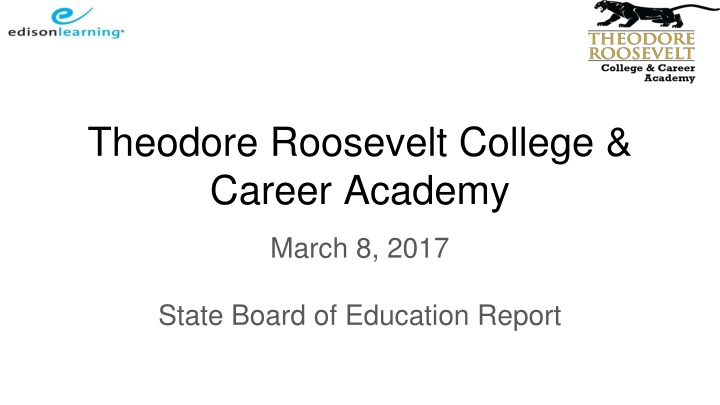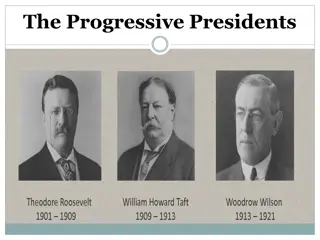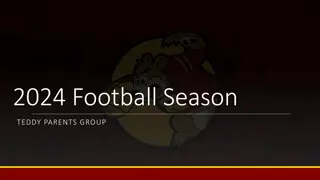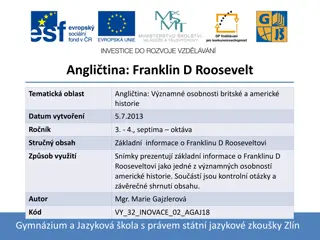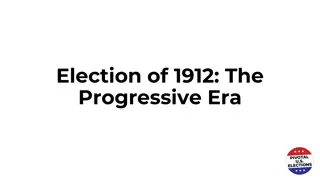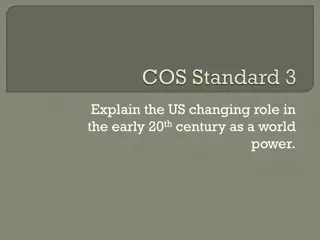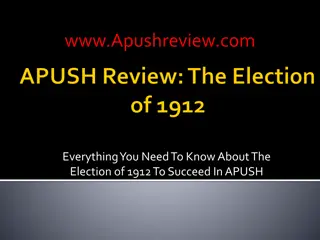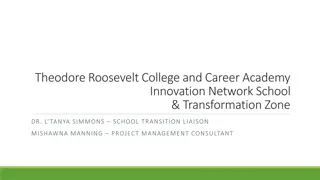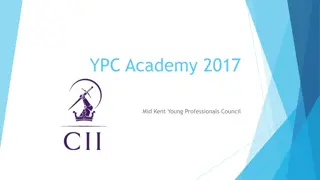Transformation Journey of Theodore Roosevelt College & Career Academy
Theodore Roosevelt College & Career Academy embarked on a transformative journey to enhance student proficiency and college readiness. By identifying systematic and academic challenges, implementing strategic plans, and embracing high-impact changes, the academy aimed to maximize student potential through quality teaching and leadership. The journey included addressing issues like school safety, academic proficiency, and behavioral management while focusing on student achievement and school improvement. Through distributed leadership and custom interventions, the academy strived to create a supportive learning environment for all students.
Download Presentation

Please find below an Image/Link to download the presentation.
The content on the website is provided AS IS for your information and personal use only. It may not be sold, licensed, or shared on other websites without obtaining consent from the author.If you encounter any issues during the download, it is possible that the publisher has removed the file from their server.
You are allowed to download the files provided on this website for personal or commercial use, subject to the condition that they are used lawfully. All files are the property of their respective owners.
The content on the website is provided AS IS for your information and personal use only. It may not be sold, licensed, or shared on other websites without obtaining consent from the author.
E N D
Presentation Transcript
Theodore Roosevelt College & Career Academy March 8, 2017 State Board of Education Report
Our Vision Every Student Proficient and Prepared for College and Careers 2
Our Mission: The mission of Theodore Roosevelt College and Career Academy is to maximize the potential of each student, creating the urgency to reach proficiency and assuring that students are given the greatest opportunity to learn and perform at high levels through premium-quality teaching and leadership as well as an effective, supportive learning environment. 3
In The Beginning Strategic Plan Development with All Stakeholders Conducted a Collaborative Quality Analysis (CQA) using our proprietary School Design Rubric to assess the school s current strengths and areas of opportunity
Systematic Challenges Pre-EdisonLearning Fear - lack of School Safety ODR - average of 180 monthly referrals Suspensions 1,827 in the first year 67% Attendance Rates Lack of a consistent, comprehensive Behavior Management System
Academic Challenges Pre-EdisonLearning 41% Graduation Rate 75% of students read fell far below grade level in Reading according to SRI & LevelSet 60% of graduating seniors enrolled in a 2-4 year college or vocational program 58% average of under-accredited students
Pre-EdisonLearning EdisonLearning
Pre-EdisonLearning EdisonLearning
Pre-EdisonLearning EdisonLearning
High Impact Systematic Changes since 2012 Distributed Leadership to focus on student achievement & school improvement Re-designed the school day to meet the needs of students Established reading, math and social interventions based on triangulated data Established the VIP attendance incentive program to motivate students /increase attendance Established a College-Going Culture (college tours, financial workshops, scholarship search) Implemented a comprehensive School Safety & Positive Behavior Discipline/Intervention Plan
Systematic Success Met 24 of 27 Contractual Metrics 57% Graduation Rate (vs. 41% in 2012) 85% of graduating seniors enrolled in a 2-4 year college or vocational program (vs. 60% in 2012) 54% Reduction of out-of-school suspensions 91.6% attendance vs. 71.4% (2013) Average of 5% in ISTEP and 6% on ECA, except for 2015 when the test changed State recognition for a safe, orderly, and caring learning environment Quality school leaders and teachers
Data Dashboard Summary Student Enrollment 700 600 500 400 FY 15-16 FY 16-17 300 200 100 0 Aug Sep Oct Nov Dec Jan Feb 12
Data Dashboard Summary Student Attendance 100 88 87 86 84.29 84 84 84 83 83 82 82 82 80 80 78 60 FY 15-16 FY 16-17 40 20 0 Aug Sept Oct Nov Dec Jan Feb 13
Data Dashboard Summary - Behaviors Suspensions Referrals 100 160 147 146 84 83 140 125 80 118 71 120 105 105 99 100 60 90 55 54 51 81 50 FY 15-16 FY 16-17 FY 15-16 FY 16-17 80 44 68 42 61 40 35 60 50 30 27 40 22 20 22 20 7 4 0 0 AugSept Oct Nov Dec Jan Feb AugSept Oct Nov Dec Jan Feb 14
Cohort Data Dashboard Summary NWEA Math 230 225.3 224 225 223 220.5 220.4 220.3 Fall 15-16 Winter 15-16 Spring 15-16 Fall 16-17 Winter 16-17 220 220 218.5 218.1 219 219 220 216.6 216.3 215.9 216 216 213.5 213.3 215 211.5 211.2 210.4 210 205 200 Grade 7-8 Grade 8-9 Grade 9-10 Grade 10-11 Grade 11-12 15
Cohort Data Dashboard Summary NWEA Reading 230 218 218 217 217 216 215 214 214 213 213 213 213 211 211 211 211 210 210 209 207 180 Fall 15-16 Winter 15-16 Spring 15-16 Fall 16-17 Winter 16-17 130 80 30 -20 Grade 7-8 Grade 8-9 Grade 9-10 Grade 10-11 Grade 11-12 16
Data Dashboard Summary - Staff Retention & Attendance Staff Retention Staff Attendance 100 100 100 98.6 99 99 99 99 99 99 99 99 99 100 96.7 98 98 97 97 96 96 96 96 96 95 95 94 95 95 95 90 85 90 90 80 75 FY 15-16 FY 16-17 85 FY 15-16 FY 16-17 85 70 65 80 60 55 75 50 Aug Sept Oct Nov Dec Jan Feb 17
Data Dashboard Summary Professional Development Unified & Differentiated Unpacking standards Lesson Planning School-wide Literacy (Informational Text & Strategies) Writing Objectives Measuring Learning 18
Effective Turnaround School Leadership Goal: Set high expectations for all students and staff by ensuring student work is intellectually challenging, and demonstrates mastery of standards, and ensure that students receive meaningful feedback Intervention: The administrative team meets weekly to review and discuss progress indivual and group progress on standards-based lesson plans, aligned assessments and student progress toward mastery. Teachers and curriculum leaders analyze lesson data and develop action plans to adjust classroom instruction, differentiating according to students academic needs and identified deficiencies. Research: http://www.ncte.org/library/NCTEFiles/Resources/Journals/EJ/1031-sep2013/EJ1031Better.pdf; http://www.ascd.org/publications/educational-leadership/dec13/vol71/num04/How-Good-Is-Good- Enough%C2%A2.aspx ; Evidence of Progress: Distributed leadership model with key leads identified and supporting implementation and monitoring goals Standards-based lesson plans showing alignment of differentiated activities, strategies and assessments Adjusted master schedule to reflect boot camp courses (Saturday School) to meet needs of all student Student work and students ability to articulate how to get to the next level in their learning 19
Effective Instruction that meets the needs of all students and is aligned with state standards Goal: Ensure teachers are using a variety of high impact pedagogical strategies to address learning gaps and engage students in their learning Intervention: School leaders conduct regular, consistent classroom observations of all staff to ensure that effective instruction is taking place and to provide constructive feedback for ongoing improvement Supporting Research: Marzano, Robert. What Works in Schools; Lemov, Doug. Teach Like A Champion. http://tntp.org/assets/tools/NSA-USI%20Increasing%20Rigor%20Throughout%20the%20Lesson-Data- Driven%20Classroom%20Best%20Pratices%20TSLT_0311.pdf Evidence of Progress: Admin create and adhere to an observation schedule where an average of 17 observations are conducted followed by individual and team feedback and coaching conversations Teachers use feedback from coaching conversations and pd to improve their practice, specifically the selection of pedagogical strategies that best align to student deficiencies 20
Using data to differentiate instruction and provide interventions Goal: Strategically align professional development to staff differentiated needs based upon teacher observations, formative assessment data, and school-wide goals Intervention: Teachers and administrators agree upon professional and personal goals, mapping out and monitoring growth plans. Using subject-specific data and feedback from staff, administrators align professional develop to meet the needs of teachers that ultimately impact school goals. Supporting Research: Bambrick-Santoyo, Paul. Driven by Data; Hattie, John. Visible Learning; The Keys to Adult Learning: Theory and Practical Strategies. Philadelphia: Research for Better Schools Evidence of Progress: Administrators share data and work with teachers and teacher teams during professional development to analyze triangulated data such as NWEA, Achieve level-set, classroom data and observation and plan lessons and activities accordingly. Through observations and feedback conversations, administrators and teachers are able to agree upon professional development needs for individual teachers and teacher teams. 21
Community and Stakeholder Input and Engagement The Roosevelt Admin and Leadership Team shares progress and gains input from community stakeholders in a variety of formats: Board Meetings Title I Parent Meeting & Monthly Parent Meeting Open Houses Capital City Partnership Purdue University Extension Program (Nutrition class for pregnant/parenting teens) Nurse-Family Partnership Program support to our pregnant teens for two years after their child's birth. 22
Next Steps Goal 1: Strategically align professional development to staff differentiated needs based upon teacher observations, formative assessment data, and school-wide goals Superintendent/Student Success Director will continue to debrief with the Principal to discuss individual and collective pd needs of teachers based on formative assessment data trends and class observations. Achievement Team meetings will continue to meet to analyze NWEA data and monitor student progress on reading and math interventions. Weekly Administrative meetings to evaluate and modify professional development and training. Goal 2: Ensure teachers are using a variety of high impact pedagogical strategies to address learning gaps and engage students in their learning Observations of best practices through nstructional rounds and weekly lesson plan reviews Coaching sessions with Achieve 3000 partners. Goal 3: Set high expectations for all students and staff by ensuring student work is intellectually challenging, and demonstrates mastery of standards, and ensure that students receive meaningful feedback. 23 Review winter NWEA score reports with students and create goals. Student recognition for NWEA achievement.
At TRCCA School Achievement is urgent & mandatory! 24
